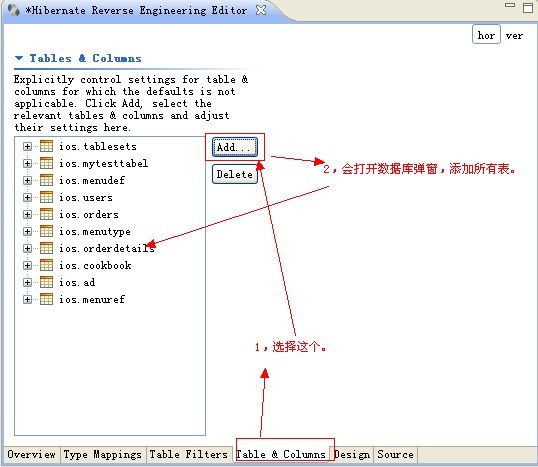前提你已经创建好了数据库,按如下操作进行:
1.添加hibernate.cfg.xml
在src下-->new-->other--->hibernate-->选择“Hibernate Configuration File(cfg.xml)”-->next-->选中项目名-->next-->填上连接数据库的必要信息-->finish

按如下方式填写好相关信息:

生成了一个xx.hbm.xml文件,但是生成有点问题,我们需要修改下,把:
<property name="hibernate.connection.url">jdbc:mysql://<host><:port>/<database></property>
改成
<property name="hibernate.connection.url">jdbc:mysql://localhost:3306/数据库名</property>
2.创建Hibernate Console Configuration
还是按如上步骤,

不用写任何东西,默认即可。
其实我们在第一步hibernate.cfg.xml 把 create console configration勾选,就不用这个步骤了。
3.
,添加:hibernate.reveng.xml
右击项目-->new-->other--->(hibernate)-->选择“Hibernate Reverse Engineering File(reveng.xml)”-->next.
会出现如下图:
我们选中相应的console configration,点击Refresh按钮,会显示该数据库对应的表格:

选中所有的表include,点击Finish,会发现在src多了个hibernate.reveng.xml。打开这个:

添加完以后,保存,关闭。
4,生成xxx.hbm.xml和bean.
启动Hibernate Code Generation Configuerations 工具,这个工具在哪里,找了好久,需要我们切换perspective。
open perspetive->other->hibernate 选择 了hibernate的perspective之后,可以看到布局变成了:

点击hibernate code generation configuration 工具,在工具栏运行后边:
 最后一个就是。
最后一个就是。

Main标签下的Output directory选择的是生成文件的位置,选择到src目录即可。Reverse engineer from JDBC Connection这个单选框很重要,选上就是了。
package不写的话默认就是src下面,写不写都可以。记住要勾选reverse enginerer from jdbc。
然后在切换到第二个选项卡exported:

执行run后便生成了相应的pojo文件:
一般自动生成的mapping文件(XXX.hbm.xml)都需要修改后才能使用。
参考了;
http://www.cnblogs.com/overstep/archive/2012/08/15/2639655.html]